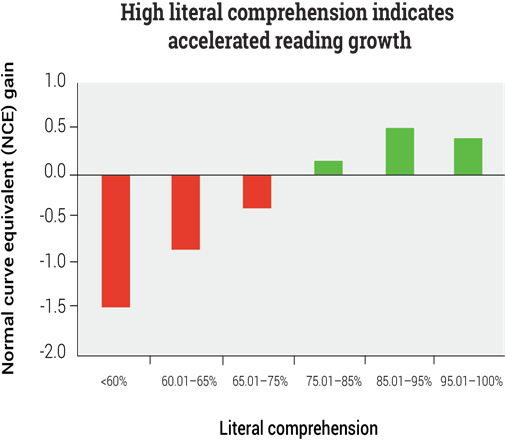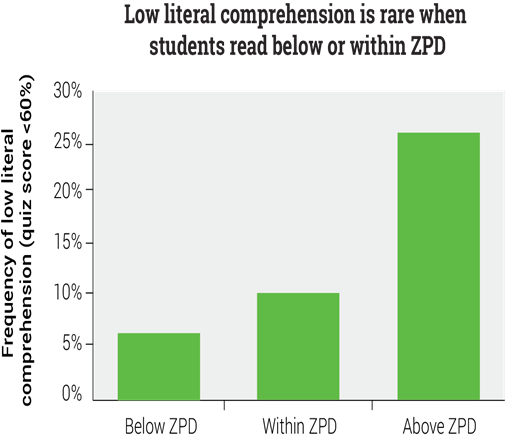Literal Comprehension and ZPD
Using Literal Comprehension and ZPD for Judging Reading GrowthEarly Comperhension Levels
Last time I wrote about the different levels of comprehension in reading performance. Today I’m going into a little deeper discussion of how we can use one of the early comprehension levels (Literal Comprehension) to help understand our kids reading growth. We are able use these tools to help us judge reading growth without the constant need for extensive testing and exams.
Remember that literal comprehension is:
1. The understanding of information and facts that are directly stated in the text.
2. What exactly is in the text, “the sky is blue”, “the water was cold”, etc.
3. Who, what, when, where?
Example questions:
• What is the girl’s name in the story?
• What did the girl do after she ate the porridge?
• Who’s house did the girl go into?
• Where was the house with the Three Bears?
Zone of Proximal Development
In this article, we also discuss ZPD (Zone of Proximal Development) and how we use these in combination to judge reading growth in students. I wrote about that a few posts ago, but a little refresher may be in order.
The concept of Zone of Proximal Development (ZPD) was first developed by a Russian psychologist Lev Vygotsky. ZPD is It is “the range of abilities that an individual can perform with assistance but cannot yet perform independently.” While this may sound complex, this concept is much more easily digested with a few simple graphs below. The concept of Zone of Proximal Development (ZPD) was first developed by a Russian psychologist Lev Vygotsky. ZPD is It is “the range of abilities that an individual can perform with assistance but cannot yet perform independently.”
In Literacy and Reading, we frequently use ZPD to describe the range of complexity that a student can read independently but not effortlessly—some may also call this a student’s “instructional level” or “independent reading level.” Reading materials in a student’s ZPD should offer just enough challenge to help them build stronger reading skills, but not so much that they become frustrated and discouraged from further reading. Think of an athlete or weightlifter as they increase their training and intensity to grow stronger and faster, progressive improvements, ZPD is essentially the same concept.
Monitoring Reading Growth
So how do we monitor reading growth without hours and hours of formal testing? How do we ensure students are truly on the path to achievement?
Research suggests there is a quick and easy way to do exactly that. A study by Renaissance of the reading habits of more than 2.2 million students using a research-based reading practice program revealed that literal comprehension can be used to predict reading gains. Students who averaged 75% or higher on the program’s short literal comprehension quizzes throughout the school year were found to have made accelerated, or higher-than-average, gains. The greatest gains were seen when students averaged 85% to 95% on quizzes. On the other hand, students with lower average scores in literal comprehension saw lower-than-average gains.
Literal Comprehension
Literal comprehension is not the end goal of reading instruction, as noted by the 5 levels of comprehension, but it is especially useful in the lower grades to help us judge and quickly assess the child’s growth and development.
High literal comprehension is the solid foundation students need to build higher levels of comprehension and skills. A low literal comprehension indicates that the fundamentals are missing which will prevent a higher level of comprehension learning from taking place. This study found that literal comprehension was a meaningful predictor of overall reading achievement and a very helpful way for educators to monitor students’ reading in the months or weeks between lengthier formal assessments.
The same study also found that, when literal comprehension dips below 60%, reading growth slows regardless of whether a student is reading below, within, or above their ZPD. This shows the importance of Literal comprehension and reading growth in the early grades.
Low Literal Comprehension
Literal comprehension below 60% is quite rare when students read below or within their ZPD. Looking at more than 112 million quizzes, the study found that students scored below 60% on only 6% of quizzes when reading below their ZPD and on only 10% of quizzes when reading within their ZPD.
As a Result
As a result, when it comes to texts within or below a student’s ZPD, teachers can use literal comprehension scores as a quick accountability check to ensure students are truly putting effort into their reading and not skimming or entirely skipping texts. If a student is putting forth the effort, low average literal comprehension with these ZPD text levels, it is likely an indication that the student is struggling with a specific concept, idea, or vocabulary term, or possibly that the student’s reading level has been misidentified and their ZPD set too high.
When we compare low literal comprehension to higher literal comprehension across all three ZPD levels—below, within, and above—we see accelerated gains occurred in only two scenarios: when comprehension was above 60% on within-ZPD and when comprehension was above 60% on above-ZPD texts.
Using these concepts is one concept that helps us to determine a child’s general reading levels. Obviously, it’s the job of the teacher to determine whether the student is simply uninterested and not performing, or is truly struggling and needs to step back a level to increase comprehension to start progressing again. A student’s effort is always going to play a significant role in their performance. That’s why we stress having FUN at The Reading Ranch attitude and effort are always key!
As Zig Ziglar said, “Your attitude, not your aptitude, will determine your altitude.”
Regards,
Dr. Kim






